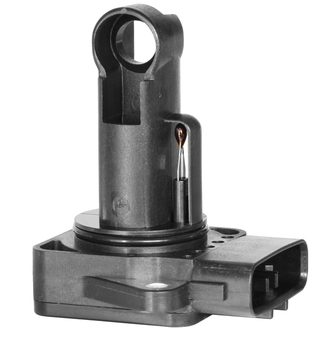Over the past twenty years, sensors in the car have become increasingly more important. As a result, cars have become considerably safer, more comfortable and cleaner. Read this overview of the most important sensors in a car.
Function of sensors
 Sensors are permanently measuring a specific actual value. They transmit a registered value to a control unit by electric or radio signal. Here, the received actual value is compared with a programmed nominal value.
Sensors are permanently measuring a specific actual value. They transmit a registered value to a control unit by electric or radio signal. Here, the received actual value is compared with a programmed nominal value.
Depending on the character of the deviation this provokes different reactions, ranging from a simple signal for indicating an error code to engaging the emergency drive of the car.

- In a technical sense, sensors are amazingly simple constructs. Many sensors in the car are simple magnet or bi-metal sensors. Their simple construction keeps their price low and guarantees maximal reliability.
- Other sensors are considerably more complex.
- Examples of high-tech sensors are the lambda sensors for measuring the oxygen content of the exhaust or radar-based proximity sensors.
Types of sensors
Sensors can be roughly categorised as follows:
|
1. Position sensors 2. RPM sensors 3. Acceleration sensors 4. Pressure sensors 5. Temperature sensors 6. Force sensors 7. Flow rate sensors |
1. Position sensors
 Position sensors measure the position of a component within a specified trajectory, which can be linear or curved.
Position sensors measure the position of a component within a specified trajectory, which can be linear or curved.
- Linear position sensors can be found on the filling level measurement of the fuel tank, the engine oil or the DEF tank.
- Position sensors for curved trajectories are alternatively called angle sensors. They register the position of the crankshaft or the steering angle. The ultrasound or radar sensors installed in the bumper count as position sensors as well.
2. RPM sensors
 RPM sensors measure the rotational speed of a component. This particularly applies to the engine: the rotational speed of the crankshaft and camshaft is essential for engine control and therefore continually measured.
RPM sensors measure the rotational speed of a component. This particularly applies to the engine: the rotational speed of the crankshaft and camshaft is essential for engine control and therefore continually measured.
 Equally important are the ABS sensors. They permanently measure if and at what velocity a wheel is rotating. The ABS sensor is a typical example of a simple, but effective sensor. It is essentially a small electromagnet in the proximity of a rotating perforated disc.
Equally important are the ABS sensors. They permanently measure if and at what velocity a wheel is rotating. The ABS sensor is a typical example of a simple, but effective sensor. It is essentially a small electromagnet in the proximity of a rotating perforated disc. As long as the control unit receives a permanent frequency of magnetic fields, it knows a wheel is turning. The simple ABS was further developed to the even more effective ESP some 20 years ago.
As long as the control unit receives a permanent frequency of magnetic fields, it knows a wheel is turning. The simple ABS was further developed to the even more effective ESP some 20 years ago.
Sensors have developed along.
3. Acceleration sensors
 Acceleration sensors are particularly important for the passive safety. When the cars picks up speed, the safety belt tensioners and airbags switch to “alarm position”. The entire suspension adjusts itself to the altered driving conditions.
Acceleration sensors are particularly important for the passive safety. When the cars picks up speed, the safety belt tensioners and airbags switch to “alarm position”. The entire suspension adjusts itself to the altered driving conditions.
4. Pressure sensors
 Pressure sensors measure the performance of gases and liquids. They transmit the actual pressure values to the control unit in the following systems:
Pressure sensors measure the performance of gases and liquids. They transmit the actual pressure values to the control unit in the following systems:
|
– fuel line – brake line – inlet duct – air conditioner – hydraulic pressure of the power steering – tyre pressure |
The permanent monitoring of the pressure in these systems is very important. Decreasing pressure in the brake or power steering lines causes loss of control of the vehicle. Lack of fuel pressure prevents the car from starting. Excessively low tyre pressure can cause the car to skid. Therefore the installation of a tyre pressure control is mandatory for all cars from construction year 2014 onwards.
5. Temperature sensors
 Temperature sensors register the heat of a specific component. This information is not only important for the driver. Generally temperature sensors serve as measuring sensor for the control unit. Only when the central brain of the car is correctly informed on the temperature conditions, it can adapt the engine control accordingly. Temperature sensors are installed in the car at the following points:
Temperature sensors register the heat of a specific component. This information is not only important for the driver. Generally temperature sensors serve as measuring sensor for the control unit. Only when the central brain of the car is correctly informed on the temperature conditions, it can adapt the engine control accordingly. Temperature sensors are installed in the car at the following points:
|
– cooling system – inlet duct – oil sump – fuel tank – interior – bodywork – air conditioner – and possibly on the tyres |
6. Force sensors
 Force sensors measure occurring forces. They are essential for the driving dynamics and the safety of the passengers. Force sensors can be found on the pedals, in the braking and steering system and for drive measurement. Modern cars have sensors in the seats as well. They issue a warning for application of the safety belt and support the belt tensioner.
Force sensors measure occurring forces. They are essential for the driving dynamics and the safety of the passengers. Force sensors can be found on the pedals, in the braking and steering system and for drive measurement. Modern cars have sensors in the seats as well. They issue a warning for application of the safety belt and support the belt tensioner.
7. Other sensors

- An air-flow sensor is used for measuring the inward air flow.

- The lambda sensor can be found in the exhaust right in front of the catalytic converter. This sensor measures the oxygen content of the exhaust.

- Knock sensors monitor the combustion in the cylinders.

- The throttle-valve sensor measures the opening angle of the throttle valve.
Small effort, great effect
Sensors are wear parts just like any other car part. If they fail, malfunctions will soon follow.

Car sensors at TOP pricesnow available from £1,52order online! ⇒ |
In the past, the search for the cause of a malfunction was an exercise of patience. Nowadays, control units check the received data from the sensors on plausibility and therefore a defective component is found more easily.
 Replacing a sensor generally provides a quick solution to a problem. Its accessibility varies considerably.
Replacing a sensor generally provides a quick solution to a problem. Its accessibility varies considerably.
Some sensors can be replaced easily and without tools. The replacement of other sensors requires an extensive repair.

- Every sensor is in essence an electronic component which can be connected to a cable harness.
- Their plugs are often an ignored error source. The contact points between sensor and cable harness are generally made of copper, which can corrode over time and interrupt the power flow. It is therefore worthwhile looking for those plugs, thoroughly scrub them clean and seal them with contact spray.
- Engine problems which at first sight look dramatic are often effectively solved in this manner.
But even if a sensor has actually failed, this only exceptionally means an economic total loss of the car. Even the replacement of components which are difficult to access like the crankshaft sensor is worth it.
Owners of older cars are therefore well-advised to inform themselves about the replacement intervals of the sensors.
- It makes sense to replace sensors preventively. More serious engine trouble is thus effectively avoided. This applies to e.g. the temperature sensor of the radiator.
- If this is replaced along with the heat exchanger or radiator fan, it enables the fan to function reliably.
- The lambda sensor should be regularly replaced as well. This spares the catalytic converter and helps saving fuel.
Foto: Andrey Suslov, autovector, Sharomka, Olga Litvinchuk, Winai Tepsuttinun, BACHTUB DMITRII, Kudrin Ilia, NONGASIMO, Poungsaed-Studio / shutterstock.com




 (8 votes, average: 3.50 out of 5)
(8 votes, average: 3.50 out of 5)







